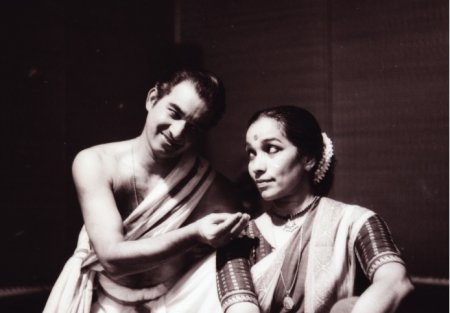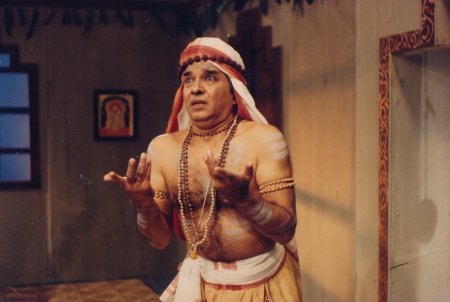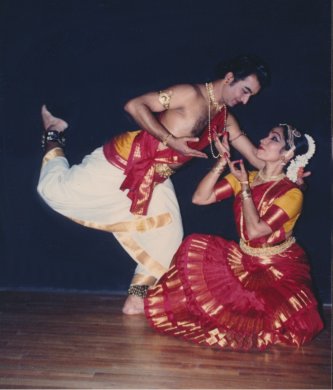
|
 |

|
 |
Sringara and Bhakti in Naatya - V. P. Dhananjayan e-mail: bkalanjali@gmail.com Photos courtesy: Bharata Kalanjali June 17, 2021 (Text of lecture demonstration given by V.P. Dhananjayan first appeared as article in 'The Journal of The Madras Music Academy Vol. LIV') Art and culture are the two inseparable aspects of human life. Art in its innumerable forms is the reflection of the creative ability of man and serves and preserves the cultural heritage of any nation. From time immemorial the different art forms have been the media for worship and a pathway to salvation or 'moksha.' Whatever we may say or do, the ultimate goal of human life is salvation. Therefore, religious institutions fostered these art forms to a high degree of perfection and thereby inculcated the spirit of righteousness through devotion to the supreme architect of this diversified universe. Amongst these beautiful creations of art, 'natya' or dance is considered to be the finest and most complete. The Fifth Veda The Natyasastra enunciates 'natya' as the fifth Veda: Jagraaha paadyam rigvedaat saamaabhyo geetaamevacha Yajurvedaat abhinayaan rasaanaam atharvanaadapi 'The knowledge of the world from Rig Veda, music from Sama Veda, the art of expression from Yajur Veda and the theory of Rasa from Atharvana Veda are taken.' Further Bharata says: Dharmyamardhyam yasasyamcha sopadesam sasamgraham Bhavishyatascha lokascha sarvakarmaanusaadham Sarvasastraartha sampannam sarvashilpa pravarthakam Naatyaakhyam panchamam vedam seitihaasam karomyaham 'For the benefit of the generations to come, I create this fifth Veda.' Therefore the significance and the importance of this scripture is clearly established. Let me also quote Bharata for the purpose attributed to these visual media of education. Uttmaadhama madhyaanaam naraanaam karmasamsrayam Hitopadesajananam dhritikridaa sukhaadikrut 'Natya teaches good things to various types of minds, Uttama the enlightened, Madhyama the educated and Adhama the illiterate. So the purpose of art is to educate the illiterate, to enlighten the educated and to entertain the enlightened. The sole purpose of 'natya' or dance, which is a judicious combination of 'gitam' or vocal, 'vadyam' or instrument and 'nrittam' or dance, is clearly established by scripture, practice and tradition as a 'Bhakti Marga,' a path of devotion. Despite these established norms, there have been contrary views trying to establish that dance has no place for Bhakti or other spiritual values but only for entertainment through various expressions of emotions, predominantly 'sringara' or eroticism.  Sringara - The king of sentiments Sringara is almost synonymous with dance, as it is the key theme depicted through this medium. This might lead some unquestioning critics to form an opinion contradictory to the original purpose envisaged by our sages and ancestors. Among the eight rasas mentioned in the Natyasastra, Sringara, which arises from the perception of love, stands first. To the best of my knowledge, there seems to be no equivalent in English for the word Sringara. The often misused term 'erotic' for Sringara, is misleading. The theme of love has been the most popular in all arts and literature all over the world and the use of the term erotic to describe the effect of any story of love, seems to have given rise to the absurd notion that almost all songs used in dance are pornographic or seductive in nature. A simple definition of this Sringara is, love between man and woman, its various manifestations and consequences. A deeper probe into it would show that Sringara is one of the Rasas that touches the heart and elevates spiritually, and leaves a cherished feeling in the mind. Some dancers and dance critics still speak of Sringara as a pornographic experience quoting various songs, which are pregnant with the emotions of love. They forget that such emotional love lyrics have been the result of, and instrumental for, a highly spiritual attunement with the Supreme Being. Bhakti is only another name for it. Take for instance Gita Govinda of Jayadeva. Though its contents are full of love play and amorous dalliances, it was written by a saint who knew nothing but Bhakti. And if he had envisaged a theme of lust and seduction for his poetry, would it be sung as a devotional hymn in the Guruvayur Temple, from dawn to dusk, every day ? There are umpteen such examples that seem profane to the shallow but in reality are spiritual expressions by the singularly blessed saint-singers, to attract the commoners' attention to Godhead through the surest means. Adi Sankaracharya describes the Sakti Mata, Mother Goddess with such anatomic explicitness as the lyrical beauty of a perfect woman. It is known as 'Saundarya Lahari' and also as 'Sringara Lahari,' When we read this, or Gita Govinda, or the eighth canto of Kalidasa's 'Kumarasambhava', do we get erotically aroused or do we experience the aesthetic beauty of the poet's expansive imagination ? Suffice to say that Sringara is the unfathomable beauty in creation that emerges from love. Every sentiment is born out of love and submerges in love. Therefore it is the main Rasa and hence is known as 'Rasa Rajah.' Bhakti or Devotion  I cannot resist quoting Rajaji's words describing Bhakti. He says, 'The way of devotion is not different from the way of knowledge or Jnana. When intelligence matures and lodges securely in the mind, it becomes wisdom. When wisdom is integrated with life and issues out in action, it becomes Bhakti. Knowledge when it becomes fully mature is Bhakti. If it does not get transformed into Bhakti, such knowledge is useless tinsel. To believe that Jnana and Bhakti, knowledge and devotion, are different from each other is ignorance.' When wisdom is integrated with reality in life, that reality in action is love for God. In the cycle of creation, love and sex are reality and beautiful creations of art, whether they be poetry, music, sculpture, painting or dance, have derived inspiration from that source of perennial beauty, which is Sringara. The soul who realizes this is a Jnani or Bhakta. Both are same according to Rajaji. The application of sringara and bhakti in dance It may leave apprehensions in the minds of connoisseurs and critics as to how the desired effect of Bhakti, or aesthetic sense of beauty can be felt by the audience watching a dance full of Nayaka-Nayika bhava, one pining for the other or describing the secret love of Radha and Krishna or illustrating the routine gesture of a prostitute who cautions her friend to 'Slam the doors in his face if he is penniless, even if he were God himself.' As I stated earlier there are gradations in the minds of people, Pamara, Pandita and Jnani, the layman, the educated and the enlightened. Hence the dancer must be careful in drawing up programs for different kinds of audience. The purpose of all art and dance in particular, is to elevate the audience to a higher level, to a higher realm of thought and vision. But the art form should not come down to earth, to the level of the lowest common denominator. Again to quote Bharata: Dukhaarthaanam sramaarthaanaam sokaarthaanaam tapaswinaam Vishraanthi jananam kaale naatyameitat bhavishyati 'Natya becomes a relaxing entertainment to the distressed, to the tired, the wearied and the sages. While it should have the quotient of entertainment, it should be construed that it should also evoke and increase Bhakti in the minds of people. Lokey bhakti vivardhanam naatya meitat bhavishyati The way of presentation is also as vast as the study of Sringara and dance and literature, and it is an impossible task to conjure up old traditions of theatrical presentation of stories in present day dance dramas. The present solo Bharatanatyam is the result of various evolutionary changes that have taken place by the passage of time. The present program and its order can be pointed out as an achievement in innovation within the borders of traditional creativity. After all, tradition is not a stinking, stagnant pond, but an ever fresh, ever renewing, ever refreshing flow like the Ganga. In the context of present day programming of Bharatanatyam, we should take into account the three types of audience as mentioned earlier. Generally an experienced dancer can gauge the audience by the organisation, occasion and environment. In my career, I have always tried to present programs to suit the predominant audience. Intelligent programming A sattvika audience, which has a three-fold perception, of intellectual, emotional and physical, all equally developed, is able to experience the performance at every level of human perception. For them, Sringara can be presented in its various shades and levels of eroticism, Bhakti Sringara, or Vatsalya Sringara, slow and medium paced songs like Kshetrayya padams or those with highly philosophical content. A rajasa audience uses its emotions and understands the performance only as sophisticated entertainment generating pleasure. For such, the 'Rati' Sringara type of songs may not give the required impact on its intellectual perception. Hence, songs with a definite story content, like Swati Tirunal's 'Bhavayami' illustrating the Ramayana, 'Pralaya payodhi jale' or others retelling the incarnations, or the many songs about Krishna's childhood doings will appeal and at the same time without lowering its taste or kindling its baser instincts. In fact, seeing such a performance evokes Bhakti Sringara in such an audience. Here the Sringara lies more in the delineation of the expression to the chosen song. Unfortunately due to social and economic factors, the sophisticated art of dance never reaches the less affluent classes whether rural or urban. They may be considered as the Tamasa audience. In actuality, one can never compartmentalize strictly according their economical status. They are mixed in different proportions in every audience. To the Tamasa audience, fast, rhythmic dance with less emotional content is more suitable and its experience of Sringara is the thrill and joy it gets out of exhilarating items like Tillana. The bhajan type of dances, with increasing pace of rhythm and lilting melodies, transports this kind of audience into the realms of devotion or Bhakti Sringara. Here I should mention the two types of 'Siddhi' (achievement) mentioned by Bharata in referring to the performer and the audience, applicable to the 'Rati Sringara' performance of a dancer. They are 'Maanushi Siddhi' and 'Daivika Siddhi,' the human and godly achievement. A well portrayed 'Sambhoga Sringara' is relished by the Sattvika (the enlightened) as a divine manifestation and he is spellbound at the ability of the dancer to act out such themes with sensitivity and effectiveness. This is 'Daivika Siddhi.' The layman might react to it in a different way. He might find it vulgar or his lower passions might be aroused. He might find it seductive and register his appreciation by untimely applause or whistling. This is 'Maanushi Siddhi.' The importance of sringara and bhakti in dance  True love is divine whatsoever its context. Of the nine rasas we usually speak of, Sringara is the only one which can take in all the others as a part of its various situations and moods. Beauty is inexhaustible in its creation and delineation. The other rasas have their limitations inherent in themselves. That is why there are innumerable varieties of love lyrics, as many types of Sringara literature. Some of these have been made a part of dance repertoire for their descriptive quality. Whereas in Bhakti there cannot be such a gamut of expressions, except perhaps for the rasas Santam and Karuna. It is possible by Sanchari bhavas, elaborations employed in abhinaya, that is, we can bring in various rasas by alluding to various tales of gods and saints and evoke Bhakti in the audience. While the Rati Sringara pieces should be presented only by a mature dancer with full understanding of the text and with an ability to present it in good taste, songs of Bhakti can be given to children. This does not mean that others should not perform such pieces. By learning such pieces, children will develop a keener interest in mythology and epics. This will in turn inculcate good discipline and standards of behaviour into them. What is the point in small children being made to do pieces like 'Mogudochi pilachedu' or varnams where the Nayika is a virahothkanthita when they don't even know and appreciate the meaning of wedlock? To sum up the content of this lecture and demonstration, let me say that Sringara is the reality in life, the proper knowledge of which matures into Bhakti. Beauty is Truth that is eternal from which everything is drawn and everything returns to it. As the Upanishad says : Poornamada poornamidam poornaatpoorna mudachyathe Poornasya poornamaadaaya poornameivavasishytei While we appreciate the beauty of the abundant arts, we should also remember that, as observed by Rabindranath Tagore, 'If beauty is to be enjoyed to the uttermost, restraint is essential. Unrestrained imagination cannot hope to create beauty in the same way as one does not set a house on fire to light a lamp. The fire must be kept in check, so that it may illuminate without destruction.'  Naatyacharya V.P.Dhananjayan is the Founder/President of Bharata Kalanjali, Chennai. Post your comments Pl provide your name and email id along with your comment. All appropriate comments posted with name & email id in the blog will also be featured in the site. |